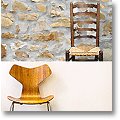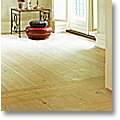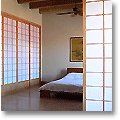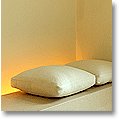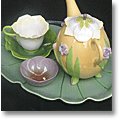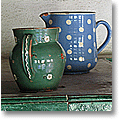Tatami Floor Mat:
The Original Japanese Mat
A tatami floor mat (a.k.a. Japanese mat) can give your home an instant 'Japanese touch'. Use a Japanese tatami mat ...
♦ for a 'zen' bedroom or an Asian style bed;
♦ to create all-natural, warm flooring, or ...
♦ as a perfect 'base' for your meditation. [Read More]
Tatami Floor Mat In A Nutshell
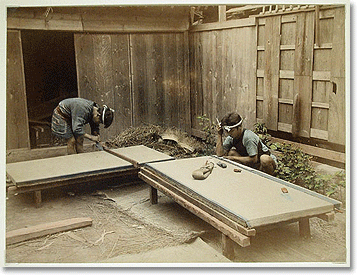
Two young men creating tatami mats. Hand colored photograph, late 19th century.
Henry and Nancy Rosin Collection of Early Photography of Japan.
Smithsonian Institution, Washington, D.C. (USA)
A Japanese tatami mat is roughly 3'x6' wide and between 1¾" and 2½" thick. You'll find regional variations in side length, but every Japanese mat is exactly twice as long as it is wide, to make sure floor patterns fit perfectly.
A tatami floor mat has a thick core of rice straw (now occasionally replaced by chipboard or polystyrene). The outer layer of a Japanese mat consists of soft, woven rush straw.
When new, the rush cover is a pale hay green color; with age and sunlight, a Japanese tatami mat will fade and turn straw yellow. The material is neither fire nor stain resistant, but it's very easy to care for. Eventually (after several years of use) the outer reed cover needs to be replaced by a professional tatami maker.
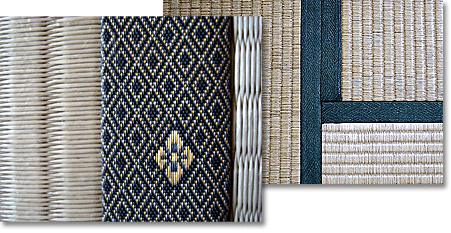
Tatami floor mat: different edgings.
© photo left (close-up): Brian LeRoux; photo right: Guillermo Ruiz
Most tatami have an edging, at least on the long sides. The most common is made of black fabric tape, but there are also brocade edgings, both in neutral colors and in vividly colored silks.
Tatami Floor Mat: History & Use
A modern Japanese mat is the end product of more than a millennium of 'design development'. Tatami mats began life as light, foldable straw mats for sitting and sleeping on:
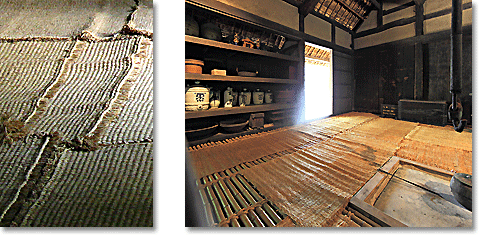
Traditional Japanese floor mats in an antique minka (farmhouse).
© photo left: Molly Des Jardin; photo right: Juuyoh Tanaka
In the following centuries, these straw mats were thickened with additional layers of rice straw, until they eventually evolved into the typical 3D Japanese mat called tatami.
Originally, tatami were a luxury item reserved for the ruling classes. They only entered regular folks' households during the late 17th century.
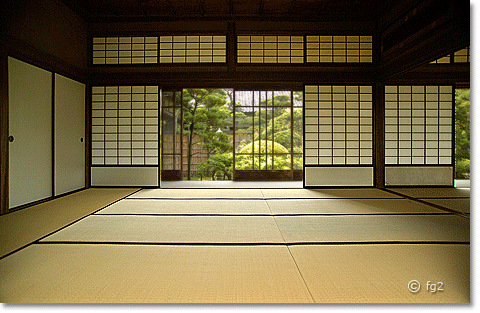
Early 20th century building in Takamatsu, Kagawa prefecture (Japan)
Not all contemporary Japanese homes have tatami-covered floors. Most of them reserve just one room (washitsu = 'Japanese-style room') for tatami flooring. And there are new Japanese homes with no tatami mats at all.
However, the traditional Japanese mat is still used as a measuring unit to estimate the size of a room, apartment, or house. Real-estate agents indicate the size of a dwelling by saying it has, for example, one 4½-mat room, two 6-mat rooms and an 8-mat room.
Here are some characteristic tatami floor patterns for Japanese room sizes:
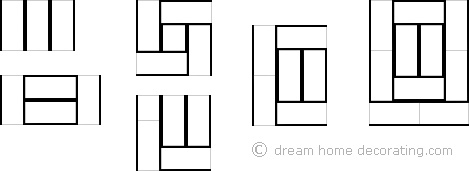
Tatami Floor Mat: Alternatives For Western Homes
When used with Western furniture, a Japanese tatami mat can have a few drawbacks : it's easily dented by the small footprints of pointy table and chair legs, and it is not made for shoes (not for anything but socks and super soft slippers, really).
Also, the measurements of Western rooms don't necessarily have the right fit for tatami floor mats. And since a Japanese tatami mat adds about 2 inches to your floor level, you also need to consider what you're going to do with your doors.
But there are other ways to achieve a 'tatami look'.
Firstly, a goza mat. woven of the same reed that is used for the top layer of a Japanese mat. Similar to the goza mat, are other natural fiber rugs you could also consider as well:
Secondly, there's always the option of a wall-to-wall natural fiber carpet made of seagrass, sisal, jute or coir. The look is similar to tatami flooring, but you don't get the typical Japanese tatami mat pattern. On the plus side, the surface is very hardwearing, and the lack of a tatami pattern means you have more freedom with the room design.
Zen Decorating Bookshop
If you would like to add a traditional Japanese touch to your home, check out this mini bookshop (in partnership with Amazon):
For non-Japanese Zen decorating ideas, you can't go wrong with books from this collection:
- The basics of Zen design
- How to sleep on a tatami floor mat: Zen bedroom design
- Creating a 'Zen' look for non-Japanese homes: Zen decorating
- Using Color In Zen Interiors:
Neutral Color Schemes - The Book:
Neutral color palettes are perfect with a tatami floor. But neutrals aren't as straightforward as many people think. Understand what makes neutral color schemes look their best, and what happens when you mix neutral color palettes with more saturate decorating colors. It's FREE!! -
Understand Interior Design Styles:
a) Interior Design Styles List
b) Interior Decorating: Style vs. Fashion


